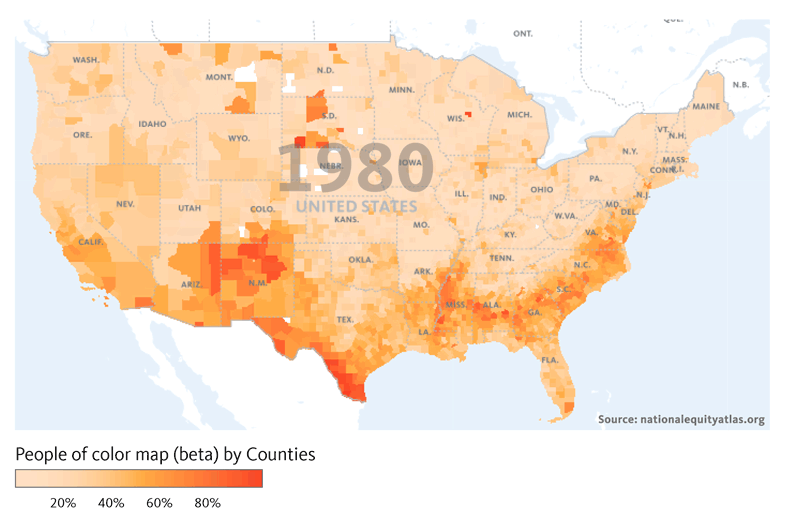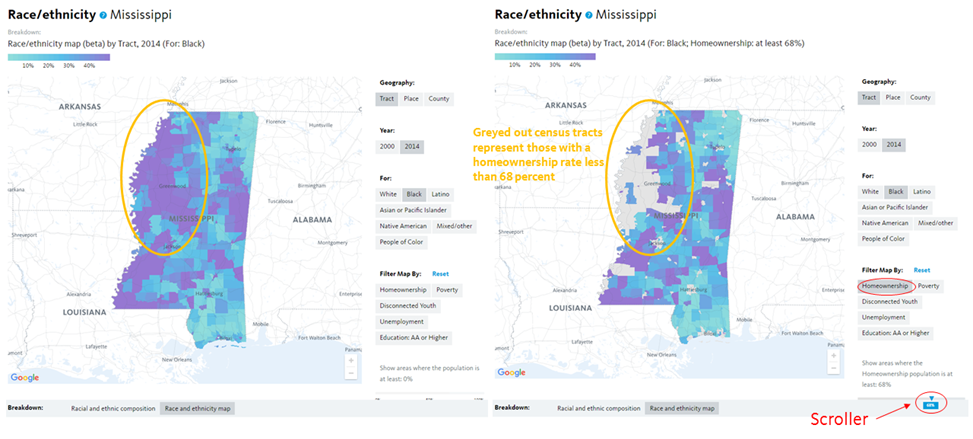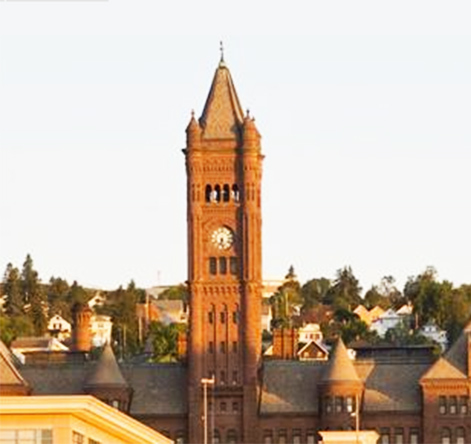We know that opportunity differs by neighborhood, and maps are one way to visualize this variation across a given city, region, or state. That’s why today, we are adding mapping breakdowns to the following four indicators on the National Equity Atlas:
These new interactive maps allow you to visualize data by county or by census tract as well as by city, region, or state. You can also toggle back and forth between different years to see how the geography of opportunity has changed over time and create custom maps using an interactive filter and scroller. On the race/ethnicity map, for example, the scroller allows you to visualize measures of opportunity (e.g. homeownership) in relation to neighborhood composition (e.g. the share of the Latino population). And on the disconnected youth and unemployment maps, the scroller allows you to visualize the indicator as neighborhood compositions (e.g. share of the Black or Native American population) vary.
This blog walks you through how to access and use the new maps. Register for our 30-minute webinar on November 2 for a live walk through.
How to find the new maps
To access the new maps for the people of color indicator, click on the Indicators tab in the top navigation bar. Then under the Demographics menu, select “People of color.” You can look at the data by county (the default), by the largest 150 regions, or by state. You can also toggle back and forth between every decade from 1980 to 2040 to see how the share of people of color in the U.S. has changed over time. The GIF below pulls from the new maps to show how the share of people of color has changed from 1980 to 2010 and how it is projected to change by 2040. You can also see the new people of color map on the homepage of the Atlas.

You can filter by White areas, Black areas, Latino areas, etc. in the people of color, unemployment, and disconnected youth maps, and you can also filter by different measures of opportunity in the race/ethnicity map. To get to the race/ethnicity indicator, select Race/ethnicity (also in the Demographics menu).
The default breakdown shows a chart of how the racial/ethnic composition of the country has changed from 1980 to 2010, and how it’s projected to change through 2040. Underneath the graphic display, you’ll see the different breakdowns, the second of which is the “Race and ethnicity map.” The default map is the percent people of color in 2014, but you can also look at the data from 2000. Under the year options, you’ll see the six major race/ethnicity groups and all people of color. If you select “Native American”, for example, you’ll get a map of the percent Native American by county. The darker purple counties represent areas with a Native population larger than 40 percent (see screenshot below).

Using the opportunity filters
The filters located on the bottom right of the page allow you create custom maps based on various measures of opportunity such as homeownership and the share of the population with an associate’s degree or higher. To illustrate how the filters work and how to access data by neighborhood, take the state of Mississippi as an example.
You’ll notice that census tracts are not one of the geography options in the map above. In order to view the data by census tract, you must type in a state, region, or city in the Explore box. After typing in and selecting Mississippi, you get a map of the state by tracts (the default geography at the sub-national level). If you click on “Black”, you get a map of the Black population share. The purple tracts are neighborhoods with a Black population greater than 40 percent. The light blue areas, on the other hand, have a Black population under 10 percent.
To use the filters, first select one, like homeownership, then move the scroller at the bottom to only show areas where the homeownership is at least a given percentage. The overall homeownership rate in Mississippi is 68 percent, but moving the scroller to 68 percent, creates a map of census tracts where the homeownership rate is 68 percent or higher and many of the purple tracts (representing majority Black tracts) in the northwestern part of the state disappear as a result (see maps below). Those tracts that disappear have a homeownership rate less than 68 percent.

Using maps to inform decision-making
These maps can be especially helpful in developing targeted employment or workforce development initiatives. The overall unemployment rate in Mississippi was 10 percent, but this was clearly not the case across all census tracts. Filtering the map by tracts with an unemployment rate of at least 15 percent produces a map with several majority Black tracts. This map can support programs and initiatives through the state workforce investment board by ensuring that resources are targeted to communities that need them most.

Note: While the size (land area) of the census tracts in the state varies widely, each has a roughly similar number of people. A large tract in a more rural part of the state likely contains a similar number of people as a seemingly tiny tract in an urban area. Care should be taken not to pay an unwarranted amount of attention to large tracts just because they are large.
Mississippi has the highest rate of disconnected youth of all states, so understanding how the number and share of disconnected youth varies across the state is central to developing an effective workforce development or education program. To find the map for disconnected youth, select “Disconnected Youth” in Readiness section of the Equity menu. The very last breakdown is the mapping breakdown. As you’ll see in the map below, there are several red census tracts, symbolizing areas where the share of disconnected youth is greater than 20 percent. As you hover over different tracts, you can see both the share and the total number of disconnected youth. In census tract 9504 in Prentiss County, for example, more than 100 young people, or 57 percent of 16 to 19 year olds, were disconnected from both school and work.

The filters and scroller on this map allow you to visualize disconnectedness in relation to neighborhood composition. As you filter to majority White or majority Black neighborhoods, you’ll notice how disconnectedness varies geographically.
For a walk through of the unemployment maps, view our previous blog. For a live walk through of the new maps, register for our webinar. Share your thoughts or questions during the webinar or through our contact form.







